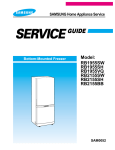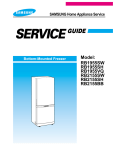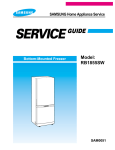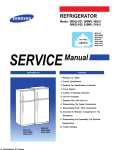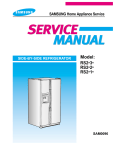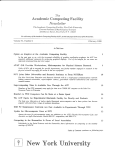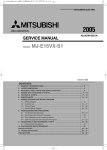Download Samsung RB1844SW Product specifications
Transcript
SAMSUNG Home Appliance Service Bottom-Mounted Freezer Model: RB1844SW RB1844SL SAM0050 WARNING IMPORTANT SAFETY NOTICE The service guide is for service men with adequate backgrounds of electrical, electronic, and mechanical experience. Any attempt to repair a major appliance may result in personal injury and property damage. The manufacturer or dealer cannot be responsible for the interpretation of this information. SAMSUNG ELECTRONICS AMERICA, INC. Technical Service Guide Copyright ⓒ2004 All rights reserved. This service guide may not be reproduced in whole or in part in any form without written permission from the SAMSUNG ELECTRONICS Company. 2 Contents 1. Installation ······································ 2. Nomenclature 4 ····································4 3. Product Specifications ·······························5 4. Electrical part specifications & standard 5. Warranty information ·····················5 ································7 6. Interior Views and Dimensions ···························8 7. Refrigeration Cycle and Cool Air Circulation Route···············10 8. Mechanical Disassembly······························12 9. Operation Function ·································19 10. Circuit Descriptions ································26 11. Diagnostics·····································34 12. Safety instruction on service ● · · · · · · · · · · · · · · · · · · · · · · Appendix Ⅰ(Reference for circuit diagnostics) 3 48 ·················49 1. INSTALLATION 1) To protect refrigerator in movement Use padded hand truck from side only. 2) Remove all protective tape and pad from the refrigerators. Connect power cord. Adjust the clearance between the doors. 3) Temperature controls ard preset in the factory for recommended settings. The refrigerator should runs smoothly and lower the temperature gradually. 4) Once the refrigerator temperature is sufficiently low It is recommended to store foods in the refrigerator. It takes a few hours to reach the preset temperatures. 2. NOMENCLATURE 2003 Models R B 20 44 SW / XAA Company Name COLOR ; SW-SNOW WHITE SL-NOBLE GRAY OPTION ; 44-NO DISPENSER Capacity ; CU. FT B - BOTTOM MOUNTED FREEZER (BMF) Product ; R - REFRIGERATOR Label Location 4 3. PRODUCT SPECIFICATIONS Model RB1844SW RB1844SL RB2044SW Type BMF 2 Door Temperature control Electronic control Total 18.7 18.7 20.4 20.4 Freezer 5.9 5.9 6.5 6.5 Refrigerator 12.8 12.8 13.9 13.9 Net Capacity 3 (ft ) Net dimension (W X D X H) Foam RB2044SL 32.3 X 28.3 X 69.9 32.3 X 30.3 X 69.9 Cabinet insulation CYCLO-PENTANE Door insulation CYCLO-PENTANE Cabinet A.B.S Door A.B.S Liner 227 Net weight(Ib) 227 241 241 4. ELECTRICAL PART SPECIFICATIONS & STANDARD STANDARD ITEM Model RB1844SW RB1844SL RB2044SW Rated Voltage 115V Frequency 60HZ Compressor Model MK172C-L2U Starting type RSCR Refrigerant R134a Oil Charge Freol α-10c(Ester), 265cc Freezer Split Fin & Tube Type Refrigerator Split Fin & Tube Type Evaporator RB2044SL Condenser Forced & Natural Convection Type Dryer Molecular Sieve XH-9 Capillary tube ID0.82 X L3000 Earth screw BSBN(Brass screw) Door switch AC125V 1.4A(SSD-6D) 5 ELECTRICAL PART SPECIFICATIONS & STANDARD ITEM STANDARD Temperature Type Freezer F-Sensor Type Refrigerator R-Sensor Temperature Selection ON(℉) OFF(℉) –14℉ –12.0℉ –16.0℉ –2℉ 0℉ –4℉ 8℉ 10℉ 6℉ Temperature Selection ON(℉) OFF(℉) 34℉ 36℉ 32℉ 40℉ 42℉ 38℉ 46℉ 48℉ 44℉ First Defrost Cycle 4hr ±10min (Concurrent Defrost of F and R) Defrosting Defrost Cycle(FRE) Min. 12hrs, Max. 22Hrs Defrost Cycle(REF) Min. 6hrs, Max. 11Hrs Pause Time 10±2min Freezer-Sensor Refrigerator-Sensor Sensor FRE Evap-Sensor THERMISTOR (502AT), SPEC:5.0KΩ AT 77℉ Electrical parts REF Evap-Sensor Ambient TEMP-Sensor Heater Defrost Heater(FRE) 242W Drain Heater(FRE) 52W Defrost Heater(REF) 120W Drain Heater(REF) 38W Thermal-Fuse for preventing overheating of Freezer Defrost-Heater AC250V 10A 77±5˚C Fuse Thermal-Fuse for preventing overheating of Freezer Defrost-Heater Capacitor RUNNING RSCR 250VAC, 12㎌ MODEL 4TM437RHBYY-53 Over-Load Protector TEMP. ON 130±5 TEMP. OFF 69±9 STARTINGMODEL J531Q33E100M200-2 RELAY OPERATION 10±20% FRE. IS3210-SNP6D MOTORREF. IS3208-SNP6H FAN CIRCUIT IS3208-SCH6A FRE(INCANDESCENT) 110V-130V/15W LAMP REF(INCANDESCENT) 110V-130/30W 6 5. WARRANTY INFORMATION 7 6. Interior Views and Dimensions 6-1) Shelves and Bins • Deli drawer • Door Bin Pull it out to disassemble. Push it up and slide it out to disassemble. Light • • • • Gallon Bin • Glass Shelf • Pull it out until its stop Tilt down and slide it out. • • Vegetable Drawer • • • Freezer Drawer • Ice trays 8 Interior Views and Dimensions 6-2) Dimensions of Refrigerator (Inches) MODEL A B C RB1844 RB2044 24.3 28.3 57.8 26.3 30.3 59.8 9 7. Refrigeration Cycle and Cool Air Circulation Route 7-1) Refrigerant Route in Refrigeration cycle Compressor → Sub condenser → Cluster pipe → Hot pipe → Dryer → Capillary tube → R-Evaporator → F-Evaporator → Accumulator → Suction pipe → Compressor 10 Refrigeration Cycle and Cool Air Circulation Route 7-2) Cool Air Circulation 11 8. Mechanical Disassembly Refrigerator Disassembly Control Panel ········································ 13 Refrigerator Light ······································ 14 Freezer Light ········································ Evaporator Cover in the Refrigerator ·························· 15 ····························· 16 ································· 17 Evaporator Cover in the Freezer Evaporator in the Freezer 14 Evaporator in the Refrigerator ······························ 17 Machine Compartment & Electric Box ··························18 12 Mechanical Disassembly Control Panel 1. Remove the screws. 2. Pull out the control panel. 3. Disconnect the wire connector. 13 Mechanical Disassembly Warning Always unplug the power cord before replacing the refrigerator lamp. There is the danger of electric shock. Refrigerator Light Freezer Light 1. Remove the screw. 1. Remove the cover by pressing the bottom tab. 2. Remove the lamp cover by unlocking the tabs and pulling the cover down. 2. Replace the lightbulb by turning it counter-clock wise. 3. Replace the lightbulb by turning it counterclockwise. 3. Reattach the cover and check the lamp by pressing door switch. 4. After replacing the bulb, reattach the cover and the screw it again. 5. Plug the power cord in and check the lamp by pressing the R-door switch. 14 Mechanical Disassembly Evaporator Cover in the Refrigerator 6. Disconnect the wire connector. 1. Remove all shelves and drawers from the refrigerator. 2. Pull out the screw caps with a small flat-blade screwdriver. 3. Remove 6 Phillps screws from the cover. ■Ductwork of the evaporator fan assembly. 4. Unlock the 2 tabs with a flat-blade screwdriver on each side of the bottom cover. 5. Remove the evaporator cover by pulling out from the bottom of the evaporator cover. 15 Mechanical Disassembly Evaporator Cover in Freezer 5. Disconnect wire connector from the top-left corner. 1. Remove all drawers from the freezer. 2. Remove screws (2) from the support rail. 6. Remove 2 screws from the rear cover of the freezer evaporator and unlock the tabs to remove it. 2 screws 3. Pull down the holder of the support rail and disconnect the wire connector to remove it. ① ② 4. Unlock the tabs around the evaporator cover from the buttom. ② ③ ① 16 Mechanical Disassembly Evaporator in Refrigerator Evaporator in Freezer Evaporator is located in the bottom of refrigerator. 1. Take off the ductwork in refrigerator. 2. Disconnect the wire connector.(Heater and Thermistor) 3. Desolder the capillary tube and the suction line from the evaporator. 4. Remove the evaporator. 5. With a file, score the capillary tube just upstream of the soldered point. Break off the soldered section to help prevent solder from plugging the tube during soldering. 6. Place a new evaporator and braze the suction and capillary tube to evaporator using silver solder. 7. Install a replacement dryer. 8. Evacuate and recharge the system using reasonable procedures. Evaporator is located in the bottom of freezer to produce cold air driven across the evaporator coils. 1. Take off the ductwork in Freezer. 2. Disconnect the wire connector (Heater, Bimental, and Thermistor). 3. Desolder the inlet and outlet tubes. 4. Remove the evaporator. 5. Take the same steps to seal the system as mentioned earlier. Accumulator Thermal Fuse Thermal Fuse Thermistor Thermistor 17 Mechanical Disassembly Machine Compartment & Electric Box 3. Mechine compartment assembly Make sure the power cord is unplugged before replacing any Warning electric components. 1. Unplug the power cord. 4. Disassemble the electric box cover after removing the screws with a Phillips screwdriver. 2. Remove the screws of the compartment cover. Slide it up and take out from the refrigerator. 5. Electric box assembly 18 9. Operation Function 9-1) Digital Panel ···································20 9-2) Temperature Control Function ·························20 9-3) Power Freeze and Power cool Functions ·················· 20 21 9-4) Sound Function ································· 9-5) Defrost Function ································· 21 9-6) Forced Operation Function··························· 22 ···················· 23 ······························· 23 9-7) Power failure compensating Function 9-8) Exhibition Function 9-9) Self - Diagnostics Function ··························· 23 9-10) Component Load Operation Function. ···················· 24 9-11) C-Fan Motor Delay function ·························· 25 19 Operation Function 9-1) Digital Panel 9-2) Temperature Control Function When the system power is initally engaged, the default set temperature are -2℉ for the freezer and 38℉ for the set refrigerator, respectively. The numbers shown on the digital display panel stand for the actual compartments temperatures. When the compartment temperatures go down, so do the numbers on the display panel, and finally they reach the set temperatures. Once the system is stabilized, the display temperatures are the set temperature. 1) Freezer Temperature Control. To select a set temperature, press the Freezer Temp. button. The display shows the set temperature from -14℉ to 8 ℉ in sequence. 2) Refrigerator Temperature Control. To select a set temperature, press the Refrigerator Temp. button. The display shown the set temperature from 34℉ to 46℉ in sequence. note) Because of the temperature sensor sensivity, the refrigerator can be under and/or over cooled when the air flow is blocked by stored foods. (Temperature range of the sensor : 15℉∼80℉) In the event of a power failure, if the freezer temperature is maintained lower than 41℉, the last selected set temperature and functions memorized in EEPROM will be restored when the power is on. 9-3) Power Freeze Function and Power Cool Functions. ● ● ● ● Select the Power Freeze or Power Cool buttons separately. These buttons are toggled ON and OFF and the indicators as well. Although you select Power Freeze or Power Cool, the set temperatures in the freezer and refrigerator are not changed. The set temperatures for the compartments can be changed while these functions are in use. 1) Power Freeze function 1-1) When you press the Power Freeze button, the LED indicator lights right away, but there is 10 seconds lag time to an actual operation. When this button is pressed again, the Power Freeze function stops and the indicator is off immediately . 1-2) If you select Power Freeze, both the compressor and the freezer fan run for 2 ½ hours continuously. 1-3) During Power Freeze, the freezer retains the current settings. 1-4) When Power Freeze expires, the indicator goes off and the freezer set temperature will be restored. 2) Power Cool function 2-1) Power Cool operation and the indicator work exactly same as the Power Freeze function. 2-2) When Power Cool is selected, COMP and R-FAN operate continuosly until the refrigerator reaches 25℉. This function will be terminated after 2 ½ hr running. 20 Operation Function 3) When you select Power Freeze and Power Cool together Each function works at the same time. The COMP and F-FAN run continuously and the R-FAN runs until 25℉ in the refrigerator. 4) Initial Power-On 4-1) When the freezer and the refrigerator temperatures are higher than 14℉ and 50℉, respectively, if Power Freeze is selected, then the R-FAN will be off. If Power Cool is selected, then the F-FAN will be off. 4-2) When both functions are selected, there is no benefit of fast cooling for each compartment. 9-4) Sound Function 1) Sound function 1-1) To make sure a command input, whenever a button is pressed, a “ding-dong” sounds. 1-2) When two or more buttons are pressed simultaneously or if a wrong button is pressed, there is no sound. 2) Door Open Alarm 2-1) When the doors remain open for 2 minutes, there are 10 times beeps. 2-2) If the doors continue to remain open more than 2 minutes, the additional 10 beeps interval will change to 1 minute. 2-3) The beeps will cease immediately when the doors are closed. 9-5) Defrost Function 1) A defrost is determined based on the accumulated compressor on-time. 2) When the power is engaged for the first time, the defrost cycle for the freezer and the refrigerator will begin after 4 hours of the accumulated compressor on-time. 3) A defrost interval depends on the ambient temperature, the number of door openings, and the door open time. 4) The defrost cycle is composed of a pre-cool process (F-Fan and COMP) for 30 minutes, a heating process, and a resting for 8-12 minutes to drain. 5) A minimum interval is 6 hours and a maximum is 11 hours for the refrigerator, and 12 hours and 22 hours for the freezer, respectively. 6) When the system runs only for the refrigerator (R-Fan and COMP) and if the refrigerator can not reach the set temperature within 2 hours, an R-defrost process will begin. 7) After the 6) process, when the compressor on-time reaches 4 hours, R-,F-defrost will begin simultaneously. 8) If a defrost cycle ocurs during Power Freeze operation, the defrost cycle will begin after the completion of Power Freeze operation. 21 Operation Function 9-6) Forced Operation function (Power cool key + Refrigerator. Temp 8sec.) This function enables a pull-down mode, a defrost mode for the refrigerator only, a defrost mode rigerator at the same time, and a cancellation of this function. ● Press Power Freeze and Refrigerator Temp. buttons for 8 seconds simultameously to get in the ready mode for a forced operation. ● The display panel will return to normal after 15 seconds in the ready mode. ● At the ready mode, press any button once to start a pull-down operation, twice for a defrost cycle for the refrigerator, three times for a defrost cycle for the freezer and the refrigerator, and finally four times for cancellation of this function. ● Another way to cancel this function is to simply plug out and in the power cord. ● 1) Pull-down Operation 1-1) At the ready mode, press any button once then the buzzer will beep (ON for 1/2 second and OFF for 1/2 second) until this mode is cancelled. 1-2) At this pull-down mode, the compressor will start immediately (No 5 minute delay) and if the system is in the defrost cycle, it will be cancelled right away. note) If this pull-down mode begins right after the compressor was off, the compressor may not start to run due to an overload condition. 1-3) At this mode, the compressor and freezer fan will operate continuously for 24 hours and the refrigerator fan will be on and off according to the set temperature(34℉) 1-4) After 24 hour operation, the system will be cycled at -14℉ for the freezer and 34℉ for the refrigerator. 1-5) In order to cancel this mode at any time, select the next mode on the ready mode or power off the system. 2) Defrost operation 2-1) At the pull-down mode, press any button again on the ready mode to begin the defrost cycle for the refrigerator. 2-2) The beep sound continues for 3 second at the beginning, then ON for 3/4 seconds and OFF for 1/4 second until this mode cease. 2-3) After this operation, the system will come back to normal operation. 2-4) At this mode, press any button again on the ready mode to operate the defrost cycles for both compartments. 2-5) The beep sound continues for 3 seconds at that time, then ON for 1/4 second and OFF for 3/4 seconds until the defrost operation cease. 3) Cancellation 3-1) At the R,F-Defrost mode, press ant button again on the ready mode to return to a normal operation. 3-2) Simply unplug the power cord, then plug it again to return to a normal operation. 22 Operation Function 9-7) Power failure compensating function 1) When the freezer temperature is lower than 50℉, all functions on the display panel will be restored. 2) When the freezer temperature is higher than 50℉, all functions will be initialized. (2℉ for the freezer, 38℉ for the refrigerator, and Cubed for the Ice Type) 9-8) Exhibition Function l This function is for a display purpose on the floor of show room or store. 1) Mode ON/OFF 1-1) For the exhibition mode, press Power Freeze and Freezer Temp. buttons simultaneously for 5 seconds until a “ding-dong” sounds. 1-2) Press the same time buttons again for 5 seconds to cancel this mode put with a “ding-dong” sound. 2) Operation 2-1) Most of the system function except the compressor operation are working properly. 2-2) There is no defrost cycle in this mode. 9-9) Self-Diagnostics function 1) Self-Diagnostics in the initial Power ON 1-1)The control board performs a self diagnostics test within 1 second and check out the temperature sensors abilities. 1-2) If a sensor failure occurs, a corresponding LED segment will blink. 1-3) When a LED segment blinks, only the cancellation function (Press Power Freeze and Power Cool buttons simultaneously for 8 seconds) is acceptable. 1-4) After a replacement of bad sensor or a cancellation of this function, this self diagnostics will end. 2) Self-Diagnostics in the normal operation 2-1) To select this function, press Power Freeze and Power Cool buttons simultaneously for 5 seconds with an audible tone. 2-2) In the self diagnostic mode, only corresponding LED segments will be illuminated (see the check list on) 2-3) After a 30 second illumination of error signal, the system will return to the normal operation. 23 Operation Function Table 1. Display table of self diagnosis. No Item LED Display Details Remarks 1 R-sensor REFRIGERATOR • Connector contact failure • Short-circuit •Suspected to be below -58℉ •Suspected to be over 150℉ 2 R-defroster sensor REFRIGERATOR • Connector contact failure • Short-circuit •Suspected to be below -58℉ •Suspected to be over 150℉ 3 Outer sensor FREEZER • Connector contact failure • Short-circuit •Suspected to be below -58℉ •Suspected to be over 150℉ F-sensor FREEZER 4 • Connector contact failure • Short-circuit •Suspected to be below -58℉ •Suspected to be over 150℉ FREEZER 5 F-defroster sensor • Connector contact failure • Short-circuit •Suspected to be below -58℉ •Suspected to be over 150℉ 9-10) Component Load Operation Function 1) In the normal operation, press Power Freeze and Power Cool buttons simultaneously for 3 second, then the display panel will blink for 2 seconds. 2) Press Refrigerator Temp. button to get into this check mode with an audible tone. 3) Each illuminating LED segment stands for the component which has an ouput signal from the control board. 4) This mode will terminate automatically after 30 seconds. 24 Operation Function FREEZER:10digit FREEZER: 1digit REFRIGERATOR:10digit REFRIGERATOR: 1digit Table 2. Display table of the presently operating parts. No Content 1 2 3 4 5 6 7 8 9 10 11 R-fan R-defrost heater Initial start mode Over load mode Low temp.mode Exhibition mode Comp F-fan F-defrost heater F-Lamp R-Lamp Display LED Operation Include R-fan activation Defrost heater activation Initial power is activated ON Outer temperature is over 95℉ Outer temperature is below 68℉ Exhibition mode is operated together Led ON when COMP activation is included Led ON F-fan activation is included Led ON when F-heater activation is included Led ON when F-lamp activation is included Led ON when R-lamp activation is included a : REFRIGERATOR 1 digit c : REFRIGERATOR 1 digit d : REFRIGERATOR 1 digit e : REFRIGERATOR 1 digit f : REFRIGERATOR 1 digit g : REFRIGERATOR 1 digit a : FREEZER 1 digit b : FREEZER 1 digit d : FREEZER 1 digit a : FREEZER 10 digit b : FREEZER 10 digit Remark Ref. 6.button scan and display circuitry ※ 3, 4, and 5 only explains the system operation states according to the ambient condition. 9-11) C-Fan Motor Delay Function of the Machine Compartment l According to the ambient temperature, the condenser fan located in the machine compartment is operated with different modes. C-FAN Delay function Operation Ranges of ambient temp. C-FAN is ON as soon as the compressor is on. Above 66℉ C-FAN is ON with 5 minutes delay from the compressor on. 61℉ ~ 65℉ C-FAN is OFF regardless of the compressor operation. Below 60℉ 25 10. Circuit Descriptions 10-1) Source Power Circuit ································ 27 ··································· 27 ····································· 28 10-2) Oscillator Circuit 10-3) Reset Circuit 10-4) Door S/W Sensing Circuit ······························ 28 10-5) Temperature Sensing Circuit ···························· 29 10-6) Key Scan and Display Circuit ···························· 30 10-7) Load Drive Circuit ·································· 31 10-8) Option Circuit ····································· 32 26 Circuit Descriptions 10-1) Source Power Circuit Circuit used Voltage (DC 12V) Relay Operation & LED Display Vcc (DC 5V) Power around MICOM & Sensor Detector 1) The input AC voltage drops to AC 8 volts on the transformer secondary side between ①~③ at CN 10. The rectified voltage passed through D101 ~ 104 becomes DC 5V through voltage regulator MC7805(REG1). This (DC5V) is supplied to the control board and sensor’s circuits. 2) The input AC Voltage drops to AC 15 volts on the transformer secondary side between ⑤~⑦ at CN 10. The rectified voltage passed through D105 ~ D108 becomes DC 12V through voltage regulator MC7812CT (REG2). This (DC12V) is supplied to the relay operation and LED display. 10-2) Oscillator circuit Port Oscillating Frequency Xin(#19) 4.00MHz Xout(#20) 4.00MHz It is designed for clock generation and time calculation for synchronizing transmission and reception on the logic elements inside the MICOM. If the X-TAL specification changes, MICOM may make an error. (The standard components should be used.) ±0.5% Error 27 Circuit Descriptions 10-3)Reset Circuit Port Voltage Vcc DC 5V Reset DC 5V When the power is supplied to MICOM, the reset circuit initializes RAM and other sectors of MICOM. A reset voltage maintains “low” for hundreds of µsec comparing to MICOM Vcc voltage when the power is in. It also maintains “high”(5V) during normal operation. But, when Vcc drops to 3.4V-3.7V, a reset port becomes “low”. 10-4) Door S/W Sensing Circuit DOOR Door Conditions Door S/W Contact MICOM PIN NO Micom Input Voltage “HIGH” CLOSE OPEN OPEN CLOSE CLOSE OPEN F # 39 “LOW” “HIGH” R # 40 OPEN CLOSE “LOW” 1) If a door is open, the door S/W contact is closed. Then MICOM receives “low” signal and detects door open, A relay control circuit receives “HIGH” signal and turn Lamp on. 2) If a door is closed, the door S/W contact is open. Then MICOM receives “high” signal and detects door close, A relay control circuit receives “LOW” signal and turn Lamp off. 28 Circuit Descriptions 10-5) Temperature Sensing Circuit ( Air Sensor) When Sensor is open When sensor is cut off MICOM input “HIGH” MICOM input “LOW” 1) The sensor uses the characteristics of thermistor. If temperature goes higher, resistance goes lower. On the contrary, if temperature goes lower, resistance goes higher. 2) A MICOM input voltage is calculated by sensor as follows. RTH (VCC : 5V, RTH : Sensor reisitance) VF = X Vcc RTH + R301 3) For the resistance data corresponding to a temperature and a MICOM input voltage, please refer the conversion table on the back. 29 Circuit Descriptions 10-6) Key Scan and Display Circuit If the IC04 decorder(KID65783AD) receives signals from MLCOM pins(34-6), an output signal per 2 miliseconds comes out from Grid#1-#7. A step DC12 volt peak will be generated periodically as follows: 30 Circuit Descriptions 10-7) Load Drive Circuit 1) Most of relays can control the compressor, heaters and several option functions. 2) For the compressor, #12 pin of MICOM signals HIGH(5V). This signal enters to #2 of IC03 and #15 of output terminal will be on and grounded. When the rely RY71 is switched to NO terminal a 115V power is supplied to the compressor. If MICOM outputs LOW(0V), the compressor will stop. 3) If the RY71 is connected to NC, RY72 and 73 for defrost heaters will be on and corresponding heater. RELAY Load Remark off Comp Operation Defrost-Heater Power Off on on Comp off, Defrost-Heater Off off on Defrost-Heater On off off Comp Off, Defrost-Heater Off COMP Defrost Heater on Comp Power Off Will be activated according to the signal from MICOM. Like the above block diagram, operation of F, R defrost heater is determined by the operation of the relay for COMP. 31 Circuit Descriptions 10-8) Option Circuit Temperature and function values can be abjustable by using main PCB switching diode. • Note : the values have been preset in factory. If is recommended not to change the value arbitrarily. When the option function is modified, a power should be turned off and on, again. 1) Freezer Temperature Shift 2) Refrigerator Temperature Shift (Unit ˚F) (Unit ˚F) SHIFT D601 D602 D603 SHIFT D604 D605 D606 Reference - - - Reference - - - -1.0 - - • -1.0 - - • -2.0 - -4.0 - -6.0 +2.0 +4.0 +6.0 • • • • • • - -2.0 - • -4.0 - - - -6.0 - • +2.0 - +4.0 • +6.0 • • 32 • • • • • • • - - - • • • - - • Circuit Descriptions 33 11. Diagnostics 11-1) If power is not ON Caution! At the power of main PCB, the 115V power and a highvoltage over DC 170V occur. Special care should be advised on repair and measurement. 34 To check the main PCB, please apply descriptions of operation and references in the manual. Diagnostics 11-2) If there is a trouble with self-diagnosis 1) If the ambient sensor has trouble. 2) If the temperature sensor of the refrigerator has trouble. 35 Diagnostics 3) If the defrost sensor of the refrigerator has trouble. 4) If the temperature sensor of the freezer has trouble. 36 Diagnostics 5) If the defrost sensor of the freezer has trouble. 37 Diagnostics 11-3) If the compressor is not working properly Pre-check 1. A compressor does not operate within 5 minutes after compressor is OFF. 2. A compressor does not run during defrost period 3. A compressor does not run because a low temperature is detected if freezer and the refrigerator sensor are not connected. 38 Diagnostics 11-4) If cooling fan doesn’t work Pre-check Select a pull-down mode from the forced operation function 1. When COMP is OFF both freezer and the refrigerator cooling fans and COMP cooling fan remain OFF. 2 . When COMP is ON, the refrigerator fan is not always ON and when the refrigerator temperature reached a set temperature, the fan goes OFF. 3. When both the freezer and the refrigerator doors are closed, each fan has a delay time (5sec ~ 1 min) and then degins to run. (COMP ON condition) 4-1) When freezer fan (F-fan) do not operate 39 Diagnostics 11-5) If the refrigerator fan doesn’t work 40 Diagnostics 11-6) If the compressor cooling fan motor doesn’t work 41 Diagnostics 11-7) No defrosting Pre-check 1. Although both F R-defrost sensors have short-circuit, a normal operation continues without a defrost cycle (Refer to self - diagnostics function) 2. When the temperature fuse is open, there is no heating and a defrost occurs naturally by the compartment temperature increase and eventually, it will cause a blinking of temperature. 3. When both F R-defrost sensors are open, heating does not end. The compressor remains off and a temperature fuse will be open. (Refer to self-diagnostics function.) 42 Diagnostics 43 Diagnostics 11-8) Alarm continuously Pre-check 1. Alarm begins after 2 minutes when the door is open and runs in every 2 minutes. 2. If the door is not closed properly, MICOM will indicate that the door is open, and alarm continues. If the alam goes for 10 minutes, the light in the compartment will be off and not be on in the situation that the door opens. 1) If melody sounds continuously 44 Diagnostics 2) If beep sounds continuously 3) When the digital panel PCB does not light 45 Diagnostics 4) When a button of the digital panel is not selected 46 Diagnostics Pre-check 1. Is the power cord connected to a wall outlet correctly? 2. Be careful of high-voltage, high-frequency discharge from the electronic ballast. 5) If the lamp of refrigerator fails to light 47 13. Safety Instructions on Service ●Unplug the refrigerator before making any repair or any replacement. Avoid the electric shock. ●Use the rated components on the replacement. Check the correct model number, rated voltage, rated current, operating temperature and so on. ●On repair, be sure that the wires such as harness are bundled tightly and are not exposed by water. Bundle wires tightly in order not to be detached by the external force. ●On repair, remove completely dust, particles or other things on housing parts, harness parts, and connectors. Cleaning may prevent fire by tracking or short. ●Check if there is any trace indicating the infitration of water on electrical parts. If there is a trace, change the related components or do the necessary action such as taping using the insulating tape. ●After repair, check the assembled state of parts. It must be the same assembled state as before. ●Check the surrounding conditions of the installed refrigerator. When the refrigerator is located at humid or wet place, or the installed state is unstable, change the location. ●If needed, do the ground. Especially, if there is a possibility of the electric leakage, this appliance must be properly grounded. ●Do not allow consumers to use one outlet for several plugs. ●Check if the power cord is placed under other appliance and so was damaged, worm-out and squeezed. Repair defective power plug or outlet immediately. Make sure that the power cord is not placed under other appliance or squeezed. ●Do not allow consumers to keep bottles or the likes in the Freezer or to keep foods in unstable position. ●Do not allow consumers to repair the appliance by themselves. ●Do not allow consumers to keep other chemicals except food. Medicines and other materials for research ; This appliance will not maintain the precisely constant temperature for them. Volatile material(Alcohol, Benzene, Ether, LP gas etc.) : possibility of explosion 48 11. PCB Circuit Diagram 49

















































